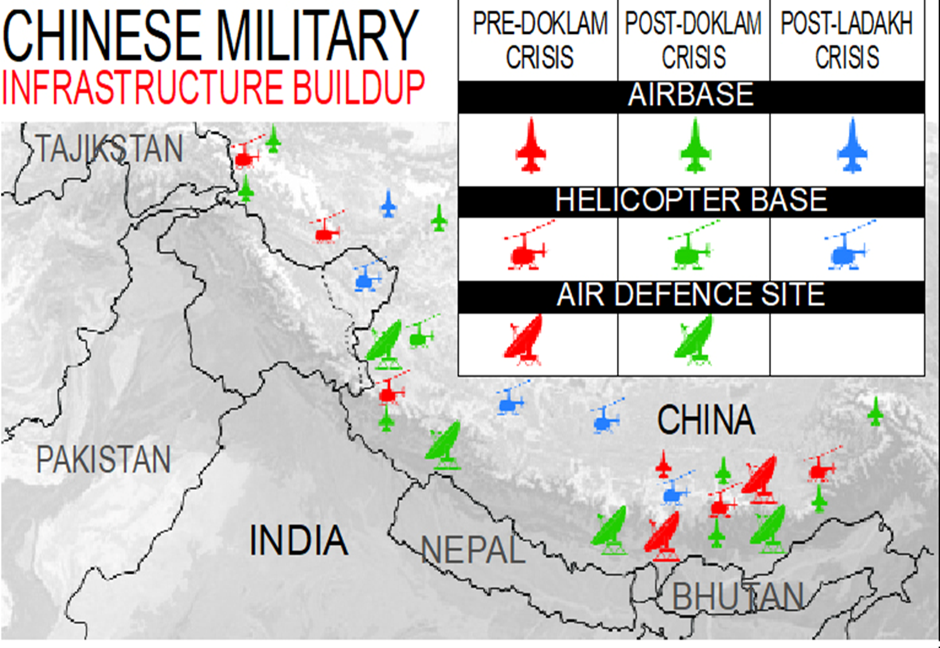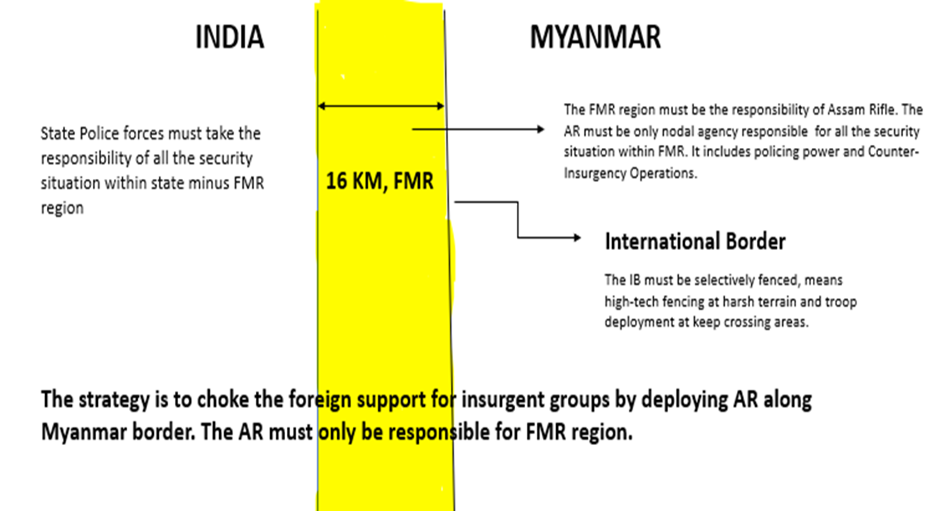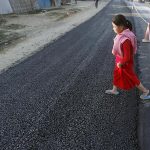The changing security dynamics of northeast India and emerging China’s challenge is pushing the Indian army to reorient itself along the Line of Actual Control (LAC) in Arunachal Pradesh.[1] The reorientation will impact the security apparatus of northeast India and other security agencies’ role in the region, especially Assam Rifle (AR) and state police forces.
For decades, the army dedicated three divisions (3 Corp) and other units in the eastern sector for Counter-Insurgency Operations (COIN). However, for quite some time, only one mountain brigade,73 Mountain Brigade, has been responsible for COIN, with an area of responsibility spreading across four districts of Assam bordering Arunachal Pradesh.[2] It also happens to be the first time that no army unit, of brigade level, is involved in COIN operations in once fragile northeast India. It indicates the improving security situation of the region; however, the changing trends and current development, especially the presence of China in Myanmar, Nepal and Bangladesh, even in Bhutan and its aggressive policy across the LAC, require a relook at the role and responsibility of security forces operating in the region.
With securing a historic third term in office, bringing back one-person rule and determination to achieve China’s rejuvenation, president Xi Jinping will adopt a more aggressive policy along LAC.[3] With the repeated infiltration, violation of the rule of engagement, enhancing military build-up [4] at the western and central sector, and building of “well-off” village,[5] intensified patrolling along the eastern sector [6] for vigilance and intelligence, China is cementing its posture all along LAC (See Picture 01). The People’s Liberation Army has always used deceptive techniques to change the status quo, including salami-slicing practices [7] to nibble the territory along the border and using a Thousand grains of sand strategy [8] to gather information. The reorientation of the Indian army is timely, considering China’s growing assertiveness along LAC. With the reorientation of the army, the role of AR, which is under dual control [9], also needs a review. With the Kargil committee report [10] advocating for ‘one border one force,’ AR performs a dual role, mainly focusing on COIN operations. Also, AR remains the only paramilitary force under dual control. Who should control the oldest paramilitary forces is nothing but a battle of turf among different ministries. The emerging challenge must subsume such debate and discussion for the larger national interest.

Picture 01 – China’s recent military build-up along the LAC
(Source – https://www.tribuneindia.com/news/nation/india-china-resolve-to-defuse-lac-tension-wont-add-troops-145304)
The continued instability in Myanmar and the large numbers of refugees taking shelter in northeastern states, the situation at the border has become volatile. According to UN estimates, more than 6000 Myanmar refugees [11] have taken refuge in northeast India, especially Mizoram. Also, the flexible Free Movement Regime (FMR) policy and prevailing drug nexus across the border, having proximity to the golden triangle, require AR to be a border guarding force. At the same time, COIN operation must be the responsibility of the state police forces.
As a purely border-guarding force, AR will undoubtedly lead to eliminating insurgency from the northeastern state, which is declining but not completely reduced. The security situation in the northeast state has improved immensely, leading to the partial removal of AFSPA [12] and increased investment and development-related activities. Today, the insurgency in the northeast has become more of a political than security challenge and therefore requires a different approach. While the enemy-centric model, cracking down harshly on insurgents, has paid dividends in the short term, long-term solutions allude to the people-centric model. The people-centric model demands holistic development of human resources by providing infrastructure, connectivity and financial initiatives. Also, robust border infrastructure, capable state police, and strong border-guarding forces support such a model.
The focus must be on building the capability and capacity of northeastern police forces to handle the COIN operations at par with the state police forces of Andhra Pradesh, Maharashtra, Jharkhand and Chhattisgarh, who, with their special police forces handles the menace of Naxalism, certainly with the support from central police forces. The greyhound model [13] of Andhra Pradesh is very successful purely because these special forces include sons of the soil in their cadre. Replicating such a model in the northeast is the need of the hour to doze off the insurgency from the region altogether. Also, the involvement of state police personnel (civil administration) rather than central armed police personnel in COIN operations will undoubtedly be seen as a positive development and enhance the locals’ confidence in the administration, thus, removing alienation.
The strong police forces will enhance the security apparatus and ease AR to patrol and guard the Myanmar border. Currently, 36 out of the 46 battalions of AR are deployed in COIN insurgency operations, creating a massive shortfall of personnel along the international border with Myanmar. Also, there are only 29 police stations [14] along the 1643 km-long India-Myanmar border. This shortfall of police personnel allows drug and illegal trade mafia to carry out their business. With continued instability in Myanmar, the drug nexus is continuing to grow and may turn the ‘golden triangle,’ infamous for drug trafficking, into a ‘golden quadrilateral’ with the northeastern part of India as a vital drug center. To check this, the AR must be the only nodal agency responsible for security and policing within the FMR (See picture 02 depicting the model). It will help to reduce cross-border infiltration, reduce drug smuggling and even check the illicit trade occurring from Myanmar. From 2020-2021, the AR seized over 1600 crore illegally traded goods in northeast India from Myanmar.[15] Some researchers even argued that China had orchestrated[16] the coup in Myanmar to push drugs, arms and terrorists into northeast India. The aim is to revive northeast India’s insurgency and keep the Indian Army engaged in the COIN operations.

Picture 02 – Showing reorientation model for security forces in Northeast India, especially AR
The economic scale of the drug in northeastern states, especially Mizoram and Manipur, keeps the insurgent group hopeful of reviving insurgency. Sharing a porous border with Myanmar, the world’s second-largest illicit opium-producing country,[17] the northeastern states, especially Nagaland, Manipur and Mizoram, are under the illegal drug nexus. Therefore, tight vigilance at the border, if not fencing it, is a step that demands urgent attention. Massive protests [18] from the locals during the initial stage of fencing the Myanmar border were seen; thereby, selective fencing is the step for the future. Selective fencing includes high-tech fences along rough terrain, including satellite monitoring and deploying AR personnel in the areas of villages having a cultural affinity with neighbouring Myanmar. The FMR policy, designed to assuage the cultural aspiration of the people living across the border, is used as a tool by insurgents to carry out illicit trade. Reconsidering the FMR policy with proper checks and balances will further ease the vigilance along the border.
Thus, with the reorientation of the Indian army in the northeastern region, it became imperative that the role of AR and the state police force also be re-oriented. The AR must be assigned all the power, policing and border guarding all along the FMR at the Myanmar border, wherein the state police force must be made capable enough to handle COIN operations within the state.
Endnotes
- Press Trust of India, “Army ‘reorienting’ forces along LAC in Arunachal Pradesh sector”, Business Standard, 08 September 2022. Available at Army ‘reorienting’ forces along LAC in Arunachal Pradesh sector | Business Standard News (business-standard.com), accessed on 10 September 2022.
- Dinakar Peri, “Insurgency down in northeast, Army shift to LAC”, The Hindu, 18 September 2022. Available at https://www.thehindu.com/news/national/northeast-insurgency-losing-public-support-recruitment-down/article65906559.ece, accessed on 20 September 2022.
- Micheal Schuman, “What Xi Jinping’s third term means for the world”,Atlantic Council, 07 October 2022. Available at https://www.atlanticcouncil.org/in-depth-research-reports/issue-brief/what-xi-jinpings-third-term-means-for-the-world/, accessed on 09 October 2022.
- Param Balakrishnam, “Since Galwan border flare up, China has installed massive military infrastructure, says the warzone”, The Telegraph Online, 07 July 2022. Available at https://www.telegraphindia.com/india/since-galwan-border-flare-up-china-has-installed-massive-military-infrastructure-says-the-warzone/cid/1874307, accessed on 08 Sepetember 2022.
- Jayadeva Ranade, “China’s Xiaokang(well-off) Border Defense Village in the Tibet Autonemous Region”, The Vivekanand Foundation, 24 September 2019. Available at https://www.vifindia.org/article/2019/september/24/china-s-xiaokang-border-defence-villages-in-the-tibet-autonomous-region, accessed on 26 September 2022.
- Harsht Sabarwal, “China continues military build-up along LAC near Eastern Ladakh: Report”, The Hindustan Times, 24 June 2020.Available at https://www.hindustantimes.com/india-news/china-continues-military-build-up-along-lac-near-eastern-ladakh-report/story-q5zQCQmi7LpUA3nYNvVxVO.html, accessed on 30 September 2022.
- Prabhash K Dutta, “What is China’s Salami Slicing tactics that Army Chief Bipin Rawat talked about?”India Today, 07 September 2017. Available at https://www.indiatoday.in/india/story/doklam-china-salami-slicing-army-chief-general-bipin-rawat-1039864-2017-09-07, accessed on 30 September 2022.
- Vaibhav Kullashri, “Understanding China’s Thousand grains of Sand Strategy”, CLAWS, 19 March 2021. Available at https://www.claws.in/chinas-thousand-grains-of-sand-approach-to-intelligence-collection/, accessed on 07 September 2022.
- Deeptiman Tiwary, “Explained:Assam Rifle dual control structure, and its role”, The Indian Express, 07 December 2021. Available at https://indianexpress.com/article/explained/explained-assam-rifles-dual-control-structure-role-nagaland-violence-7658329/#:~:text=Assam%20Rifles%20is%20the%20only,under%20the%20Ministry%20of%20Defence., accessed on 09 September 2022.
- Kargil committee report, Availabe at https://static.theprint.in/wp-content/uploads/2018/06/Kargil-report.pdf, accessed on 10 September 2022.
- Rajeev Bhattacharya, “Over 6,000 Myanmar National in India’s Northest”, The Diplomat, 26 May 2021. Available at https://thediplomat.com/2021/05/over-6000-myanmar-nationals-in-indias-northeast/, accessed on 27 September 2022.
- Deeptiman Tiwary, Tora Agarwal, “Govt removes AFSPA from parts of Nagaland, Assam and Manipur”, The Indian Express, 01 April 2022. Available at https://indianexpress.com/article/india/govt-reduce-disturbed-areas-in-3-ne-states-under-afspa-amit-shah-7846179/, accessed on 27 September 2022.
- Col JK Achuthan, “Tackling Maoist: the Andra paradigm”, Indian Defense Review, 25 May 2013. Available at http://www.indiandefencereview.com/news/tackling-maoists-the-andhra-paradigm/3/, accessed on 27 September 2022.
- Rabi Banerjee, “China might have orchestrated Myanmar coup to push drugs, arms, terrorists into northeast”, The Week, 09 January 2022. Available at https://www.theweek.in/theweek/cover/2022/01/01/china-might-have-orchestrated-myanmar-coup-to-push-drugs-arms-terrorists-into-northeast.html, accessed on 27 September 2022.
- PTI, “Assam Rifles seized Rs 1,600 crore illegally traded goods in northeast since 2020”, The Economic Times, 18 August 2021. Available at https://economictimes.indiatimes.com/news/india/assam-rifles-seized-rs-1600-crore-illegally-traded-goods-in-northeast-since-2020/articleshow/85423595.cms?from=mdr, accessed on 28 September 2022.
- 14.
- NET Desk, “Manipur Government Appeals Centre To Suspend Fencing Work Project Along Disputed Indo-Myanmar Border “, Northeast Today, 23 June 2022. Available at https://www.northeasttoday.in/2022/06/23/manipur-government-appeals-centre-to-suspend-fencing-work-project-along-disputed-indo-myanmar-border/, accessed on 27 September 2022.













